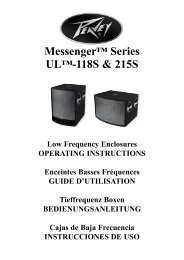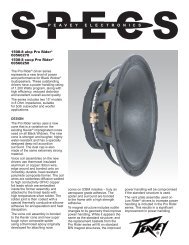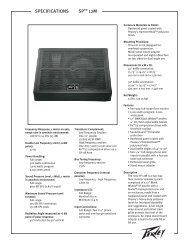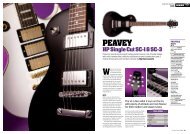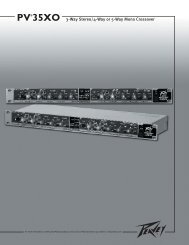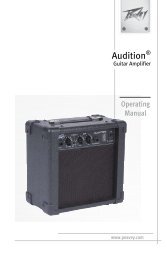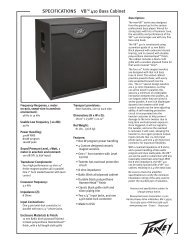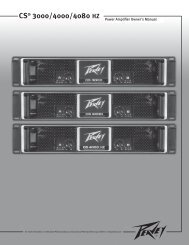Bass Guitars - Peavey
Bass Guitars - Peavey
Bass Guitars - Peavey
Create successful ePaper yourself
Turn your PDF publications into a flip-book with our unique Google optimized e-Paper software.
<strong>Bass</strong> <strong>Guitars</strong>Owner's Manual
Passive <strong>Bass</strong>GuitarConfiguration56738910111243211. Volume2. Tone Control3. Pickup Blend Control4. Strap Button5. Bridge6. Bridge Pickup7. Neck Pickup138. Position Markers9. Frets10. Fingerboard11. Nut12. Tuning Keys13. String Retainer2
567Active <strong>Bass</strong>GuitarConfiguration43891011123 2 11. Volume2. 3 band active EQ with+-/10 dB boost or cut3. Pickup blend control4. Strap Button5. Bridge6. Bridge Pickup7. Neck Pickup8. Position Markers139. Frets10. Fingerboard11. Nut12. Tuning Keys13. String Retainer3
CongratulationsSo, you are the owner of a new <strong>Peavey</strong> <strong>Bass</strong> Guitar. Congratulations! Yourpurchase proves your taste in musical instruments is superb. <strong>Peavey</strong> offers a widevariety of bass guitars for beginners to professionals, each with unique qualities andfeatures. While our professional luthiers have carefully inspected your guitar, everymodel requires some initial set-up and periodic maintenance is required for peakperformance.To insure proper care of your quality instrument, visit www.peavey.com/accessoriesfor <strong>Peavey</strong> recommended accessories, parts and cleaning supplies.4
Cleaning & CareWhen properly cared for, your <strong>Peavey</strong> bass will offer you years of pleasure.Playing your bass means that you will need to perform regular, generalmaintenance, such as cleaning and proper storage, to keep it looking andsounding great.Every time you play your bass, body oils and perspiration are transferred to thebody, back of the neck, headstock, fingerboards, strings, tuners, pickups andbridge. After you finish performing, but before you put your bass away, take amoment to remove these contaminants.5
Cleaning - WoodTo clean and care for the major wood parts of your bass guitar(body, headstock and the back of the neck), <strong>Peavey</strong> recommendsthat you use a clean, soft, lint-free, dry cotton or<strong>Peavey</strong> Micro Fiber cloth and specially formulated HP'sAxe Wax available at www.peavey.com/accessories.Use of an inappropriate “rag” or polish may resultin scratching the finish of your instrument.WARNING: Use of abrasives or solventswill permanently damage yourinstrument's finish.
Cleaning - FingerboardProperly caring for your fingerboard requires special attention. Over time, a fingerboard may lose itsnatural oils and shrink or exhibit a worn or faded appearance. <strong>Peavey</strong> recommends that you periodicallyapply a small amount of Lemon Oil (available at www.peavey.com/accessories) to your fingerboard (afterremoving strings) using a clean, soft, lint-free, dry cotton cloth. Remove excess oil immediately using aclean, soft, lint-free, dry cotton cloth. With Lemon Oil, like all oils, a little goes a long way. Make sure touse only a small amount. How do you know when it is time to replenish your fingerboard? You can watchfor a change in the appearance of your wood, or set a routine calendar date. However, do not allow toomuch time to pass as permanent damage may occur. If you allow the wood on the fingerboard to dry outand shrink, the frets will “stand-out” and feel rough to the touch.7
Cleaning - MetalTo clean and lubricate the major metal parts ofyour bass (strings, pickups, bridge, tuners), <strong>Peavey</strong>recommends that you use a clean, soft, lint-free,dry cotton cloth and specially formulated guitarstring cleaner available at www.peavey.com/accessories.Don’t just wipe down the tops of your strings.Individually clean strings by wrapping each onein a fold of cloth, running it back and forth alongthe string’s entire length until the cloth fails topick up any more residue. Failure to routinelyclean and lubricate the metal parts of yourinstrument, including strings, may result inrusting.WARNING: Use of abrasives or solventswill permanently damage your finish.8
Storage & TravelYour bass is a piece of art that must be protected.When you are traveling with your instrument,loosen the tuning knobs a turn or two totake pressure off he neck, and protect it witha gig bag or case. While a gig bag offers someprotection, mainly from dust, a hard case offersthe best protection. If you plan to store yourbass for a long period of time (we don’t knowwhy you would want to), remember to slightlyloosen your strings to relieve pressure on theneck. As with any piece of art, don’t throw it inyour trunk and leave it when it’s -10° or 110°!Keep you bass stored at room temperature,and avoid extreme changes in temperatureor humidity.9
AccessoriesAdd-on products like stands, hangers, and straps that are made of plastic, rubber,or man-made materials may chemically or physically react with and damage thefinish of your <strong>Peavey</strong> bass. (<strong>Peavey</strong> offers a full line of safe products available atwww.peavey.com/accessories).Every player needs a strap for peak performance, however, straps and strapbuttons are designed for “ordinary” use. If you anticipate “above ordinary” use,<strong>Peavey</strong> recommends that you use Super Strap Locks to secure your strap to yourbass (See <strong>Peavey</strong> accessories www.peavey.com/accessories).REMEMBER: <strong>Peavey</strong> Care Kits offer the bestvalue for your money. Visit www.peavey.com/accessories to place your order.10
StringsOld strings produce dull, buzzing or dead notes, while a new set of strings ring clearand true. If you play often, you will need to change your strings often. A good ruleof thumb is that if you play daily, you should change strings every couple ofweeks. Replace your strings as you notice them becoming dirty or discolored,before you experience a disappointing loss of performance.See page 12 for detailed instructions on changing strings.11
Changing Your StringsUnless you are reconditioning your fretboard (see care andcleaning), strings should be changed one at a time to maintainproper neck tension. New strings should be free of defects(twists, kinks, bends) that can cause sound irregularities orbreakage. All strings are prone to stretch, particularly uponinstallation. After your first tuning, carefully pull each stringaway from the fretboard, stretching it gently (too much forcewill break thinner strings). Then, retune your guitar.<strong>Peavey</strong> recommends that you replace strings in the samegauges to maintain proper neck and/or bridge tension. If youwish to change strings with different gauges, <strong>Peavey</strong> recommendsthat you enlist the services of a qualified technician tomake the required truss rod and/or bridge adjustments on yourinstrument.12Standard Tuning(thickest string to thinnest)4-String <strong>Bass</strong> TuningOpen noteE A D GString 4 3 2 15-String Standard Low BAdds one lower pitched stringOpen note B E A D GString 5 4 3 2 15-String Alternative High CAdds one higher pitched stringOpen note E A D G CString 5 4 3 2 16-String <strong>Bass</strong> TuningOpen note B E A D G CString 6 5 4 3 2 1
Changing Your StringsChanging strings on a <strong>Peavey</strong> bass guitar is a simple task that will bring new life to your instrument.Tools Needed:Wire cuttersElectronic tuner or pitch pipe (optional)Note: <strong>Peavey</strong> recommends changing one string at a time to maintain proper tension on the neck andbridge. Replace strings with the same gauges or you will need to make truss rod, spring tension, andintonation adjustments as described in this manual.First, detune the thickest, top string (the 6th, 5th, or 4th string, depending on your model) using themachine head tuner—two or three full turns should remove the tension on the string. Remove the stringfrom the tuning peg; at the other end of the string, pull the ball end of the string and remove the stringfrom the instrument. (You may wish to cut off the portion of the string previously wound around the tuningpeg to make this task easier.)13
Changing Your StringsFollowing the path of the string you just removed, insert the plain end of a new string through the holein the bridge and thread across the string saddle, up the fingerboard, across the nut, through the stringguide (if one is provided), and into the small hole in the corresponding machine head tuning post. (Theball end of the string will secure the string to the bridge.) At the headstock, allow 2-3 inches of stringbeyond the post for turning around the machine head post, and cut string. Insert the freshly cut stringend into the hole in the center of the tuning post. Then, bend the string at a right angle at the edge ofthe slot and begin winding the string onto the post. Note that the string path should be straight, runningfrom the fretboard, over the nut, through the string guides (if provided), to the post—without anglingoff. To avoid slippage, wind strings tightly from top to bottom on each post, completing 2-3 wrapsaround each post. Keep a light pressure on the string with the fingers of your other hand while tighteningthe string using the tuners. (An inexpensive, optional peg winder makes winding much easier.) Tuneto pitch. Because new strings are prone to stretch when first installed, you should gently stretch thestring by pulling it away from the neck and retune again.14
Changing Your StringsNote: Do not make saddle adjustments unless you are changing string gauges, which also requirestruss rod and intonation adjustments.Repeat this procedure for the remaining strings, remembering to tune each to pitch before proceedingto the next string. Hint: To prevent detuning from slippage, always tune UP to the correct pitch. Retuneeach string until strings hold their relative pitch to one another.15
Tuning Machine AdjustmentsOver time, tuners can become loose. Get in the habit of checking the tension with every string change. Ifyou notice a change in the tension of a tuner, use a small flathead or Phillips screwdriver (some requirean allen wrench) to tighten it (turn clockwise) or loosen it (turn counterclockwise) accordingly.Warning: While the screw should be snug, do not over-tighten as you may strip the screw.16
String action refers to the distance between the strings andthe frets on a stringed instrument. <strong>Peavey</strong> technicians carefullyset optimal string action on each bass guitar beforeit leaves our factory; however, conditions such as changesin temperature and moisture (humidity), changing stringgauges, making neck adjustments, or tuning can alter stringaction enough to require a height adjustment to restoreyour guitar to factory specifications. Undesirable low actioncauses buzzing, while abnormally high action makes yourbass difficult to play.String ActionBefore making string action adjustments, make sure yourtruss rod is properly adjusted and your bass is in tune. Then,refer to the chart below, checking each string’s height at the15th fret using a steel ruler for best accuracy. Measurementsare taken from the top of the fret to the bottom of each string.17
Pickup AdjustmentsFactory settings place pickups at the same volumelevel; however many players change the height of oneor more neck or bridge pickups to create their ownoutput levels. To keep yourfactory warranty intact, <strong>Peavey</strong> suggests you take yourbass to an authorized <strong>Peavey</strong> Service center to have thepickup adjustments made.18
IntonationA properly intoned bass guitar will sound in tune no matter where you play alongthe fretboard. <strong>Bass</strong> intonation describes the accuracy in relative pitch (of your basswith itself) as you play the same note or chord. Intonation is determined by thelength of each string as controlled by the location of each string’s saddle. To checkintonation, complete all adjustments to the truss rod and string action, andtune your guitar. Then, compare the fretted sound of the 12th fret to theopen harmonic of the 12th fret. (Harmonics are created by lightly placing afinger against a string [in this case, at the 12th fret] and striking normallywith your picking hand. You’ve done it correctly if you hear a clear, loud,bell-like tone.) If the notes are the same, no adjustment is required. If theydo not match, you will need to fine-tune each offending string using theadjustment screws to move the saddle location. If the fretted 12th note isflat, adjust the saddle toward the neck. If sharp, move it away from the neck.(Note that on some bass guitars, you will need to loosen strings first beforemaking saddle adjustments.) Repeat the process until the fretted sound ofthe 12th fret matches the open harmonic of the 12th fret.19
20Neck and Truss RodEvery <strong>Peavey</strong> bass guitar features an adjustable truss rod inside the neck. Truss rodsallow for adjustments in the neck to accommodate changes in string tension causedby humidity, changing string gauges, or tuning. As the backbone of your instrument,truss rod adjustments should always be performed as the first step in instrumentsetup. (<strong>Peavey</strong> recommends that you enlist the services of a qualified technician tomake the required truss rod adjustments on your instrument. Improper adjustmentmay damage your neck and void your <strong>Peavey</strong> warranty.) To gain access to the trussrod, look for a 4 mm or 8 mm allen wrench adjustment screw either at the end ofthe neck near the body or at the opposite end near the headstock. Note that somebass guitars may require neck removal to gain access to the neck pocket truss rod.The goal of truss rod adjustment is to create the correct amount of bow in yourbass guitar’s neck to facilitate optimal playability.To check the neck’s bow, hold the guitar in normal playing position and followthis procedure for the both outside strings (highest and lowest strings). Fret andhold the string at the first fret, while fretting and holding the same string withyour picking hand thumb (where the neck and body meet, typically around the16th fret). Then, stretch your picking hand index finger as far as you can to fret
Neck and Truss Rodthe middle area of the neck, somewhere around fret 7-8-9. The distance your string travels to meet thefret is the bow. <strong>Peavey</strong> recommends a .3 mm to .5 mm (.010” to .020”) bow, easily measured and setwith a steel rule. Too much bow leads to buzzing in the middle of the neck because the strings are toofar away from the frets, while too little bow (backbow) causes excessive buzzing on open notes andnotes near the nut.To make adjustments for neck bow or relief (backbow), adjust the truss rod in 1/4 turn increments,and then recheck. If your neck is backbowed, loosen the truss rod by turning it counterclockwise. If ithas too much bow, tighten the truss rod by turning clockwise. Remember, a little truss rod adjustmentmakes a big change in neck attitude. Improper adjustment may damage your neck and void your <strong>Peavey</strong>warranty.21
WarrantyYour <strong>Peavey</strong> Warranty covers defects in material and workmanship in <strong>Peavey</strong> products purchased and serviced in the U.S.A. and Canada.What This Warranty Does Not CoverThe Warranty does not cover: (1) damage caused by accident, misuse, abuse, improper installation or operation, rental, product modificationor neglect; (2) damage occurring during shipment; (3) damage caused by repair or service performed by persons not authorizedby <strong>Peavey</strong>; (4) products on which the serial number has been altered, defaced or removed; (5) products not purchased from an Authorized<strong>Peavey</strong> Dealer.Who This Warranty ProtectsThis Warranty protects only the original purchaser of the product.How Long This Warranty LastsThe Warranty begins on the date of purchase by the original retail purchaser. The duration of the Warranty for guitars is 2 years *(+ 3years). [* denotes additional warranty period applicable if optional Warranty Registration Card is completed and returned to <strong>Peavey</strong> byoriginal retail purchaser within 90 days of purchase.]What <strong>Peavey</strong> Will DoWe will repair or replace (at <strong>Peavey</strong>'s discretion) products covered by warranty at no charge for labor or materials. If the product orcomponent must be shipped to <strong>Peavey</strong> for warranty service, the consumer must pay initial shipping charges. If the repairs are covered bywarranty, <strong>Peavey</strong> will pay the return shipping charges.How To Get Warranty Service(1) Take the defective item and your sales receipt or other proof of date of purchase to your Authorized <strong>Peavey</strong> Dealer or Authorized22
Warranty<strong>Peavey</strong> Service Center.OR(2) Ship the defective item, prepaid, to <strong>Peavey</strong> Electronics Corporation, International Service Center, 412 Highway 11 & 80 East, Meridian,MS 39301. Include a detailed description of the problem, together with a copy of your sales receipt or other proof of date of purchase asevidence of warranty coverage. Also provide a complete return address.Limitation of Implied WarrantiesANY IMPLIED WARRANTIES, INCLUDING WARRANTIES OF MERCHANTABILITY AND FITNESS FOR A PARTICULAR PURPOSE, ARE LIMITEDIN DURATION TO THE LENGTH OF THIS WARRANTY.Some states do not allow limitations on how long an implied warranty lasts, so the above limitation may not apply to you.Exclusions of DamagesPEAVEY'S LIABILITY FOR ANY DEFECTIVE PRODUCT IS LIMITED TO THE REPAIR OR REPLACEMENT OF THE PRODUCT, AT PEAVEY'S OP-TION. IF WE ELECT TO REPLACE THE PRODUCT, THE REPLACEMENT MAY BE A RECONDITIONED UNIT. PEAVEY SHALL NOT BE LIABLE FORDAMAGES BASED ON INCONVENIENCE, LOSS OF USE, LOST PROFITS, LOST SAVINGS, DAMAGE TO ANY OTHER EQUIPMENT OR OTHERITEMS AT THE SITE OF USE, OR ANY OTHER DAMAGES WHETHER INCIDENTAL, CONSEQUENTIAL OR OTHERWISE, EVEN IF PEAVEY HASBEEN ADVISED OF THE POSSIBILITY OF SUCH DAMAGES.Some states do not allow the exclusion or limitation or incidental or consequential damages, so the above limitation may not apply toyou.This Warranty gives you specific legal rights, and you may also have other rights which vary from state to state.If you have any questions about this warranty or services received or if you need assistance in locating an Authorized Service Center,please contact the <strong>Peavey</strong> International Service Center at (toll-free) 877-732-8391 or customerservice@peavey.com. Features and specificationssubject to change without notice.23
Features and specifications subject to change without notice.<strong>Peavey</strong> Electronics Corporation • 5022 Hartley <strong>Peavey</strong> Dr • Meridian, MS 39305(601) 483-5365 • FAX (601) 486-1278 • www.peavey.com© 2013 EX000058



